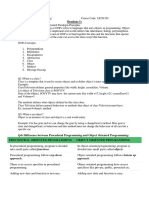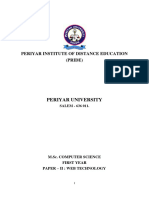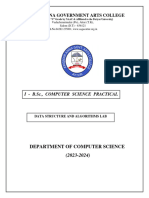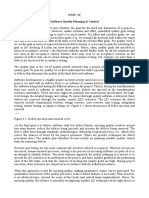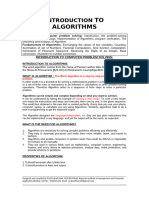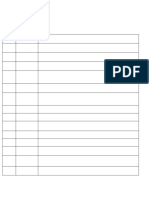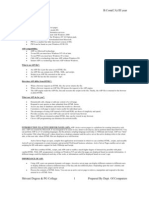0 ratings0% found this document useful (0 votes)
167 viewsChapter-9 Creating A Django Based Basic Web Application
The document discusses creating a basic Django web application. It explains that Django is a Python-based web framework that prevents repetition of work. It provides steps to install Django and create a project, apps, models, templates, and views. The models define how data is stored and processed. Templates are created for each app and views receive requests and return responses in the form of templates.
Uploaded by
Swarnim JainCopyright
© © All Rights Reserved
Available Formats
Download as PDF, TXT or read online on Scribd
0 ratings0% found this document useful (0 votes)
167 viewsChapter-9 Creating A Django Based Basic Web Application
The document discusses creating a basic Django web application. It explains that Django is a Python-based web framework that prevents repetition of work. It provides steps to install Django and create a project, apps, models, templates, and views. The models define how data is stored and processed. Templates are created for each app and views receive requests and return responses in the form of templates.
Uploaded by
Swarnim JainCopyright
© © All Rights Reserved
Available Formats
Download as PDF, TXT or read online on Scribd
You are on page 1/ 10
Chapter-9
Creating a Django based Basic Web Application
Introduction :Django is a web framework that is used along with Python
to develop dynamic websites.
Web Framework – A Web Framework is a software tool that provides a
way to build and run dynamic websites and web-enabled applications.
How Web, Websites and Web-application Work ?
Web works in the form of client-server architecture. Our web
browser act as a client program (web client or the front-end), and
the web server with which it interact is the server (the backend).
The client (web browser) work on the web mostly with HTTP protocol.
The client make an HTTP request , which the (web) server responds to
in the form of a response called HTTP response.
The client mostly make these two types of HTTP requests:
Introducing Django: Django is python based free and open source web
application framework. It prevents repetition of work.
Installing Django:
To install Django on Windows , follow the steps given below:
(i) Connect to internet
(ii) Start cmd (Windows 7) or Windows Power Shell (Windows 10) in
administrator mode.
(iii) go to the folder where you want to install virtual environment by
using CD command.
(iv) type the following command to download and install virtual
environment
(v) now type following command
(vi) Nowactivate virtual environment by giving activate command.
(vii) Once activated, install Django :
Creating a Project in Django:
Creating Apps of a Django Project :
First go inside the outer project folder online_shop (because
manage.py reside in it) and then issue command:
Register apps – Register apps with project after creating them.
Open inner project-name folder’s setting.py file and add apps names in
the INSTALLED APPS list.
Creating Models : Models in Django refer to the way data is stored and
processed. The data model for an app is defined inside model.py file of
the app folder.
Creating Templates : After creating apps and their models, create
templates for each app.
1. Create a folder templates inside BASIC DIRECTORY (outer project
name folder)
2. Stores desired html files inside templates folder.
3. Next , Add the name of templates folder in the DIRS settings
under TEMPLATES of setting.py file of your project (inner project
name folder)
Creating views : Next, create views. Views receive the request in the
form of URL and provide response in form of templates.
Go inside products app views.py and define view function :
Go inside inner project folder online_shop urls.py file and edit:
You might also like
- Michael Aaron Piano Course Theory Primer by Michael Aaron0% (1)Michael Aaron Piano Course Theory Primer by Michael Aaron5 pages
- AEM Training - Adobe Experience Manager Training OnlineNo ratings yetAEM Training - Adobe Experience Manager Training Online12 pages
- Django: Writing Your First Django App, Part 2No ratings yetDjango: Writing Your First Django App, Part 212 pages
- Unit I: Web and Internet Technologies (15A05605) III B.Tech II Sem (CSE)No ratings yetUnit I: Web and Internet Technologies (15A05605) III B.Tech II Sem (CSE)50 pages
- Prog Lab-II-Data Structures Using C-Lab ManualNo ratings yetProg Lab-II-Data Structures Using C-Lab Manual140 pages
- Unit - Iv Software Quality Planning & ControlNo ratings yetUnit - Iv Software Quality Planning & Control11 pages
- Cs 72 Mobile Computing 2 Mark Questions Unit I 1) What Are The Categories of Mobile Services?No ratings yetCs 72 Mobile Computing 2 Mark Questions Unit I 1) What Are The Categories of Mobile Services?20 pages
- The Complete Reference Java - Lecture Notes, Study Material and Important Questions, AnswersNo ratings yetThe Complete Reference Java - Lecture Notes, Study Material and Important Questions, Answers208 pages
- Introduction To Django 1221867881702938 8No ratings yetIntroduction To Django 1221867881702938 817 pages
- DWDM Unit-3: What Is Classification? What Is Prediction?No ratings yetDWDM Unit-3: What Is Classification? What Is Prediction?12 pages
- JAVA-UNIT-4-Managing Exception, Applet Programming PDFNo ratings yetJAVA-UNIT-4-Managing Exception, Applet Programming PDF71 pages
- Nta Ugc Net KEY TO SUCCESS in Computer ScienceNo ratings yetNta Ugc Net KEY TO SUCCESS in Computer Science61 pages
- 02 Fundamentals of The Analysis of Algorithm EfficiencyNo ratings yet02 Fundamentals of The Analysis of Algorithm Efficiency49 pages
- VI - Computer Studies - Evolution of ComputersNo ratings yetVI - Computer Studies - Evolution of Computers18 pages
- Introduction To Problem Solving Techniques: StructureNo ratings yetIntroduction To Problem Solving Techniques: Structure14 pages
- UNIT-1 Introduction: Dr. C.Nagaraju Head of Cse Ysrec of YVU Proddatur100% (1)UNIT-1 Introduction: Dr. C.Nagaraju Head of Cse Ysrec of YVU Proddatur86 pages
- Specification For Hot Axlebox Hot-Cold Wheel Detector 22-03-2012 - Revision 2No ratings yetSpecification For Hot Axlebox Hot-Cold Wheel Detector 22-03-2012 - Revision 218 pages
- WAS 7 For Linux Platforms Download FilesNo ratings yetWAS 7 For Linux Platforms Download Files11 pages
- How To Automate Login A Website Java ExaNo ratings yetHow To Automate Login A Website Java Exa10 pages
- Reddy, Niyanthesh - MKT 3600 Firm Activity AnalysisNo ratings yetReddy, Niyanthesh - MKT 3600 Firm Activity Analysis49 pages
- Empowerment Technologies Self Learning ModulesNo ratings yetEmpowerment Technologies Self Learning Modules15 pages
- Chapter One Living in A Digital GenerationNo ratings yetChapter One Living in A Digital Generation7 pages
- Michael Aaron Piano Course Theory Primer by Michael AaronMichael Aaron Piano Course Theory Primer by Michael Aaron
- AEM Training - Adobe Experience Manager Training OnlineAEM Training - Adobe Experience Manager Training Online
- Unit I: Web and Internet Technologies (15A05605) III B.Tech II Sem (CSE)Unit I: Web and Internet Technologies (15A05605) III B.Tech II Sem (CSE)
- Cs 72 Mobile Computing 2 Mark Questions Unit I 1) What Are The Categories of Mobile Services?Cs 72 Mobile Computing 2 Mark Questions Unit I 1) What Are The Categories of Mobile Services?
- The Complete Reference Java - Lecture Notes, Study Material and Important Questions, AnswersThe Complete Reference Java - Lecture Notes, Study Material and Important Questions, Answers
- DWDM Unit-3: What Is Classification? What Is Prediction?DWDM Unit-3: What Is Classification? What Is Prediction?
- JAVA-UNIT-4-Managing Exception, Applet Programming PDFJAVA-UNIT-4-Managing Exception, Applet Programming PDF
- 02 Fundamentals of The Analysis of Algorithm Efficiency02 Fundamentals of The Analysis of Algorithm Efficiency
- Introduction To Problem Solving Techniques: StructureIntroduction To Problem Solving Techniques: Structure
- UNIT-1 Introduction: Dr. C.Nagaraju Head of Cse Ysrec of YVU ProddaturUNIT-1 Introduction: Dr. C.Nagaraju Head of Cse Ysrec of YVU Proddatur
- Specification For Hot Axlebox Hot-Cold Wheel Detector 22-03-2012 - Revision 2Specification For Hot Axlebox Hot-Cold Wheel Detector 22-03-2012 - Revision 2
- Reddy, Niyanthesh - MKT 3600 Firm Activity AnalysisReddy, Niyanthesh - MKT 3600 Firm Activity Analysis









